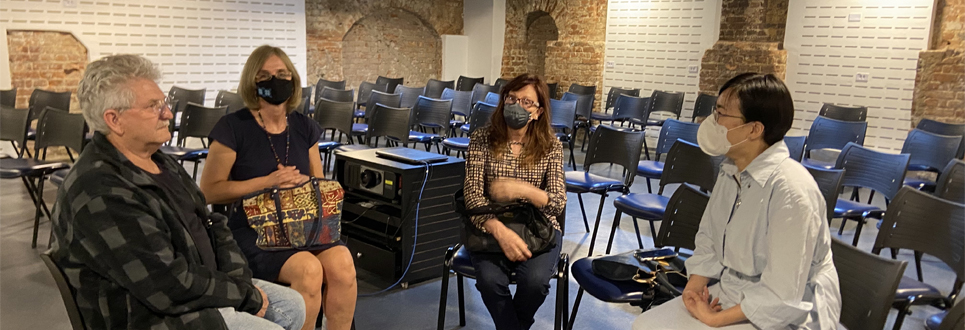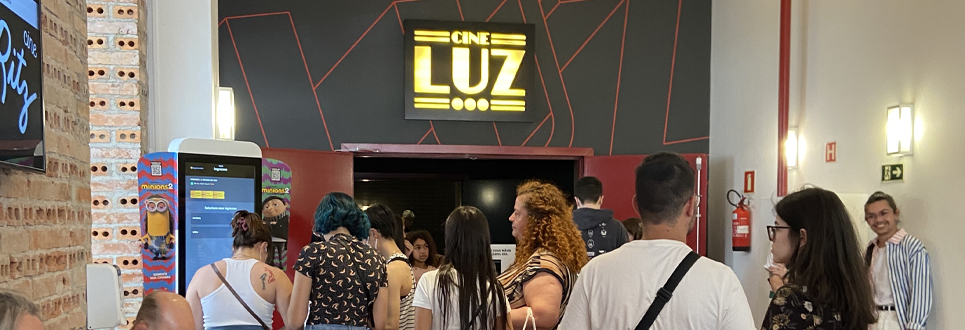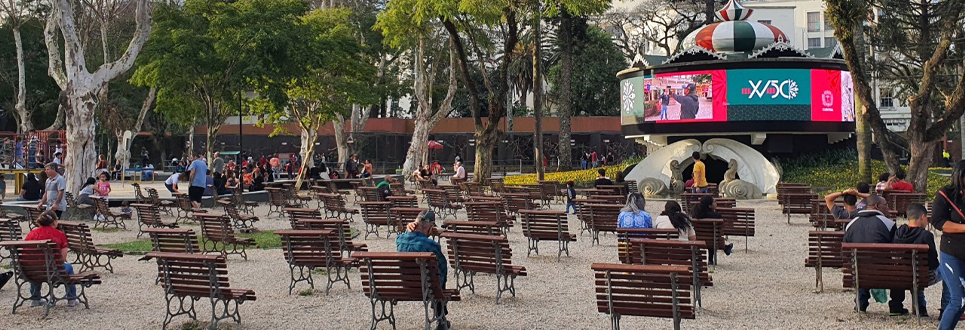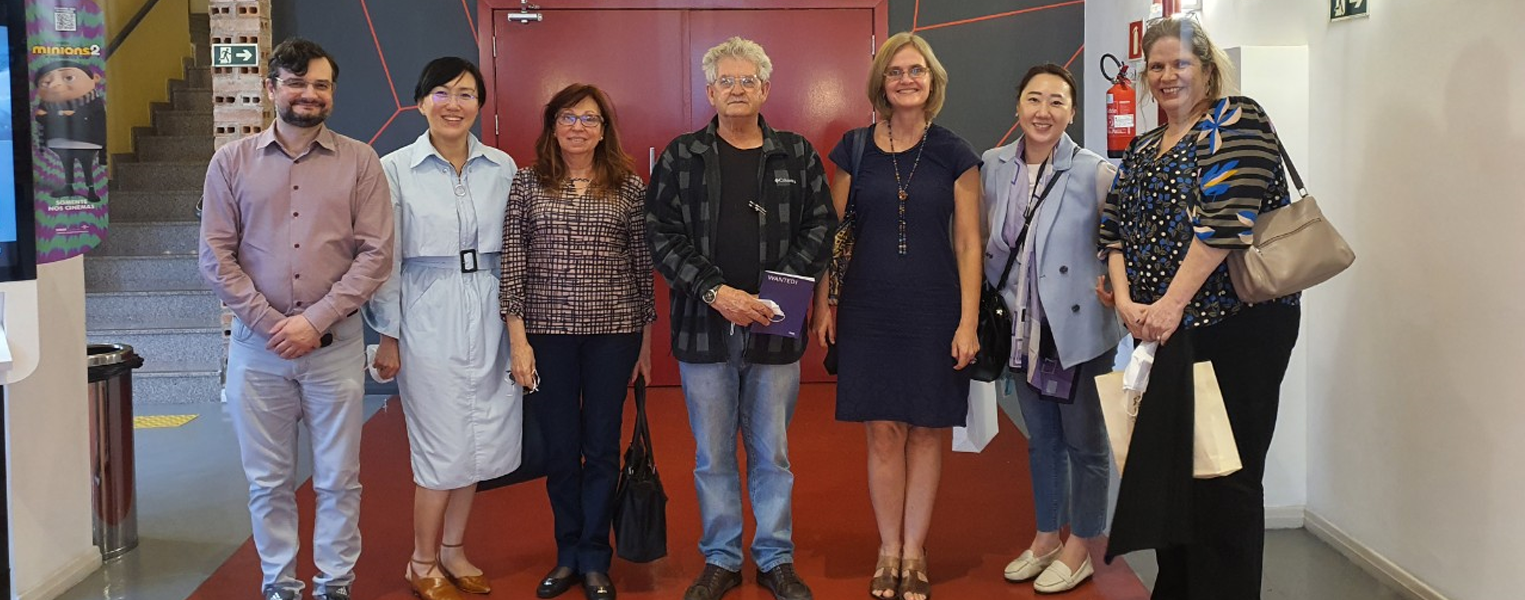NEWS
HumanCityDesignAward NEWS LETTER - Cine Passeio Interview
2022.07.28
SPECIAL INTERVIEW
Honorable day meeting the designers of Cine Passeio.
Date : 3-5PM Saturday 16th of July 2022
Place : Cine Passeio, Passeio Publico (Curitiba, Brazil)
Interviewees :
- Mr. Mauro Magnabosco: Representative Architect of Cine Passeio (IPPUC)
- Mrs. Carla Choma Frankl: Architect of Cine Passeio (IPPUC)
- Mrs. Doris Teixeira: Architect of Cine Passeio (FCC)
- Mrs. Liana Vallicelli: Architect, Director of Information of IPPUC
- Mr. Marino Galvao Junior: Executive Director of ICAC
*IPPUC - Institute for Research and Urban Planning of Curitiba
FCC - Cultural Foundation of Curitiba
ICAC - Curitiba Institute for Art and Culture
The 14th UNESCO Creative Cities Annual Conference was held in Santos, Brazil, in 2 years after the COVID-19 Pandemic.
While in Brazil for the conference, we visited Cine Passeio, whose project earned the Honorable Mention title at the 3rd Human City Design Award.
There, we also had the “honor” of interviewing people from the IPPUC (Institute for Research and Urban Planning of Curitiba) who designed Cine Passeio.

During a long-haul flight of around 30 hours, we happened to meet a very kind Curitiban.
His name was Rafael Rehme.

His response and kindness made us more curious as to what Brazil, which we have only seen through photos, videos and Zoom, and in particular,
Cine Passeio and the architects who designed it may look.
Cine Passeio was a project carried out as part of a plan to revitalize the streets of Riachuelo, a historic district in the city center of Curitiba in southern Brazil.
Cine Passeio was refurbished from a military building built in 1934 - while preserving and utilizing its original state as much as possible - into a complex cultural space
where people can enjoy while nurturing arts and culture. It was opened in 2019 and is evaluated as a successful public space for citizens' leisure and commercial facilities.

The first impression we got after arriving at Cine Passeio was that it was very neat and tidy.
It was contrary to the common belief that movie theatre lobbies are dark and closed spaces with poor ventilation and filled with the smell of popcorn.
Cine Passeio shared only the smell of popcorn in common with other movie theatre lobbies. Rather, it was a more comfortable and bright space with a fresh breeze.
In the coffee shop on the ground floor, we could feel the tranquillity and happiness of the locals sitting there.

We got immersed in the atmosphere for a while. Then the architects and program planners from the IPPUC came by,
and we conducted the interview in an atmosphere as comfortable as Cine Passeio.
Q. What was the reason for the construction of Cine Passeio?
A. It was built to revitalize the surrounding area centred around Riachuelo street in downtown Curitiba since 2010 while using the building with
a completely new purpose without damaging the architecture of the old military base and pedestrians. See that wall over there? Isn't there something
strange about it? It's still using old bricks from before. Even the window frames are still intact.

Q. Why did you plan this place with the theme of movies?
A. Two movie theaters were built in Curitiba in the 1930s, named ‘Lux’ (light) and ‘Ritz.’ In those days when movies were not easily accessible,
these two cinemas were a place of rest, entertainment and exchange for the citizens of Curitiba at the time.
After that, they moved and operated the second ‘Lux’ and ‘Ritz’ from 1950 to 1980, but they disappeared over time.
So, with ‘movies’ as the medium, we wanted to provide citizens, children, and students with a space to relax and a place for cultural education.
Similarly, by carrying on with the names of the old movie theatres, we wanted people to enjoy themselves together, bringing back their memories

Q. Are there any other must-visit places in Curitiba?
A. It would be Passeio Publico Park.
Brazilians all gather in the park on weekends.
It used to be a zoo, but now they installed LED screens to show various content like photo exhibitions and movies.
It is worth noting the width of the benches there. Although they may appear ordinary, their width is deliberately made large enough for one person
but a little cramped for two. During the pandemic, the design proved very effective for keeping distance.

Q. Lastly, what does Brazilian design ultimately intends to achieve?
A. It is sustainability. It's the design that can be shared by everyone without compromising the space while maintaining
local characteristics - something that everyone can sympathize with and enjoy over time.
We thank Mauro, Liana, Carla, Doris and Marino for their hospitality and kind introduction, and Daniele for arranging the meeting.

After the interview, we looked around every nook and cranny of Cine Passeio.
The rooftop was equipped with a deck and kitchen facilities where you can hold various events. In the space connected to the outdoors, movies could be screened.
For that, they said that local citizens mainly use it in summer. What sets this space apart from other movie theatres is probably this.
they created a natural space where light permeates the window by the road and the wind blows softly.
Indeed, this 'comfort' must be the reason why many young people and their families come to Cine Passeio, as well as the elderly who share the memories of old movie theatres.

In addition, in order to expand the scope of 'comfort' from ordinary citizens to the socially disadvantaged, Curitiba City is in the process of upgrading the range of services
by renting machines specially developed for the visually and hearing impaired.
What was most delightful and moving to us was their plan to use the prize money they had received from the Human City Design Award for building a new 3D movie theatre.
A 3D movie theatre is something that children from low-income families often don't get to experience because the price is too high.
However, through this occasion, they will be able to provide such cultural experiences at one-third of the price.

This was exactly what the Human City Design Award pursues after.
What can we do to improve the society and make our citizens’ lives better?
This does not just end by thinking about this together or creating a space or object. It is also about providing and operating ‘sustainable’ programs.
The answer to the last question was coexisting in both the Brazilian design and at the Human City Design Award.
The Brazilian design was not only practical and purpose-oriented but also fun and humorous. It could make people closer to each other or provide a safer environment
from infectious diseases.
And not just a place limited for special people, but for a place for all.
That is what Cine Passeio was all about.